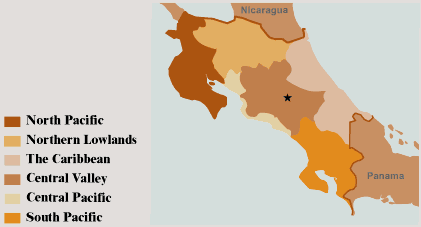Overview
Situated between 8° and 11° North latitude (550 – 750 miles north of the equator), Costa Rica is renowned as an atmospheric paradise. Mild subtropical conditions prevail year-round and temperature extremes and prolonged overcast periods are practically nonexistent. Temperatures vary mainly according to elevation: the higher, the cooler.
Annual rainfall averages 100 inches nationwide with some mountainous regions getting as much as 240 inches on exposed eastern slopes. A lot of rain compared to the U.S., where only a few states – Alaska, Hawaii, New Hampshire and Washington – approach 100 inches of precipitation per year. Temperature is more a matter of elevation than location with a mean of around 72 degrees in the Central Valley, 82 degrees on the Atlantic coast and 89 degrees on the Pacific coast. Costa Rica’s rain falls mainly on the Caribbean coast, giving the Pacific a much more arid climate.
Like the Southern Hemisphere, Costa Rica’s seasons are reversed relative to the U.S. While the states are enduring winter weather December through April, Costa Rica is enjoying summer. However, Costa Rica is not in the Southern Hemisphere, it’s in the Northern, providing further evidence that climate is a complex phenomenon. In Costa Rica, weather is influenced significantly by proximity to the equator, wind, rain, and topography, particularly dramatic differences in elevation.
Two seasons – rainy and dry
The dry season runs from December through April and the rainy season from May to November. The seasons were named by early Spanish colonizers, who compared them to their own Mediterranean climate, calling the dry months “verano” or summer, and the rainy months “invierno” or winter. Some of the coldest temperatures are registered during the early dry season or “summer”.
The Central Valley – Home to Ricovida and year-round Spring-like Weather
In the Central Valley, where Ricovida Rio Grande is located, temperatures average 78°-80°F each day with low-moderate humidity. The entire valley is several thousand feet above sea level which accounts for a mild, pleasant dry season that is matched by moderate temperatures for most of the year, and a lower than average amount of rainfall. The sun shines nearly every day, even in the Green (rainy) Season. Early settlers prized the area for both its mild climate and fertile soils. The Central Valley may well have the best climate in the world.

